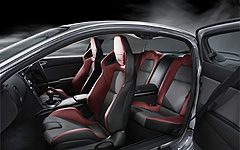Mazda's final RX-8 a chance for Oz
BY MARTON PETTENDY | 14th Oct 2011

Spirit R is the same name given to the last version of the two-door RX-7 coupe before it was effectively replaced by the RX-8 here in July 2003.
Whether or not it becomes available here, Mazda stresses the RX-8 will remain available in Australia for at least the next 12 months.
“The limited-edition model is something we’re considering but have yet to make a final decision on,” Mazda Australia spokesman Steve Maciver told GoAuto.
“It is correct that RX-8 production ceases next year, but we can confirm that the RX-8 will remain a part of the Mazda line-up here in Australia well into 2012.”Mr Maciver said Mazda Australia was discussing details such as pricing and sales expectations for the RX-8 Spirit R with Mazda Motor Corporation in Hiroshima, but that final decision would not be made within the next two weeks.
Mazda will officially release the Spirit R in Japan on November 24 and plans to produce just 1000 examples.
To be available in both six-speed manual and automatic transmission guises, it will be produced in Aluminium metallic, Sparkling Black mica and Crystal White Pearl mica exterior paint colours.
All RX-8 Spirit Rs will feature a number of cosmetic upgrades inside and out, including black-bezel headlights, foglights and tail-lights, red brake callipers, a piano-black transmission tunnel and exclusive badging.
In addition, manual versions will be equipped with unique Recaro Spirit R bucket seats and bronze 19-inch alloy wheels with 225/40 R19 tyres, while automatic models will come with sports suspension, larger brakes, Gun metallic 18-inch alloy wheels with 225/45 tyres, leather seats and steering wheel trim with black and red stitching, and red-stitched parking brake lever and front/rear centre console trim.
Mazda once again reiterated its commitment to a next-generation rotary model to replace the RX-8 when it announced the Spirit R last week.
“Mazda’s iconic rotary engine recorded its famous victory in the Le Mans 24-Hour endurance race 20 years ago,” said MMC representative director, chairman of the board, president and CEO, Takashi Yamanouchi.
“Throughout 2011, we have been celebrating the 20th anniversary of that victory by demonstrating the winning 787B racecar at Le Mans’ Circuit de La Sarthe and various other events around the world.
“At each one, the screaming rotary engine and the sight of the 787B have enthralled everyone from young children to race fans who witnessed its victory in 1991. These events have been a powerful reminder of the widespread passion for the rotary engine.
“Although RX-8 production is ending, the rotary engine will always represent the spirit of Mazda and Mazda remains committed to its ongoing development.”

Central to the future of the unique Wankel engine configuration at Mazda are improvements in efficiency to meet tightening global emissions standards.
Apart from its high combined fuel consumption (12.9L/100km manual, 12.1L/100km automatic), the RX-8’s 1.3-litre engine has also been criticised for its oil consumption and lack of bottom-end torque.
It remains unclear whether Mazda’s all-new Sky-Rotary will power a conventional two-door sports coupe, or a four-door ‘coupe’ in the vein of either the RX-8 or the sleek Shinari sedan concept that debuted Mazda’s new Kodo design language (as seen on the upcoming CX-5 compact SUV).
Mazda has ruled out a rotary-engined version of its next MX-5 roadster/coupe, but could apply the RX-9 nameplate to the RX-8 successor when it appears around 2013.
In a new twist to the Mazda rotary saga, however, a more recent Twitter posting from the car-maker’s Japanese public relations team this week highlighted the development of a next-generation rotary engine for more than one future Mazda model.
“Thank you so much for all your supportive messages concerning the RX-8 and the rotary engine! We are also excited,” said the translated Twitter post in response to feedback from enthusiasts about the demise of RX-8 production in Japan next June.
“Mazda is aiming to achieve a breakthrough with the ‘SkyActiv’ technology, and we are zealously working on new models to house the next generation rotary engine. Thank you for your continued support!”Whatever Mazda has in store for rotary fans, expect a combination of all of the company’s SkyActiv engine and transmission advances, wrapped in a chassis made from a high proportion of high-strength steel and a Kodo-styled body that blends slippery aerodynamics with advanced construction techniques to deliver maximum performance and efficiency with minimum weight, friction and drag.
Mazda highlighted the history of its association with the rotary engine as part of the RX-8 Spirit R announcement.
After signing a technical contract with NSU and Wankel in July 1961, a host of rotary-powered models followed, starting with the Cosmo Sport 110S in May 1967 and including the Familia Rotary Coupe/Mazda R100 in July 1968, the Luce Rotary Coupe/Mazda R130 Coupe in October 1969, the Capella Rotary/Mazda RX-2 series in May 1970, the Savanna Rotary/Mazda RX-3 in September 1971 and the Luce Rotary/Mazda RX-4 series in November 1972.
Mazda racked up production of 500,000 rotary-powered vehicles in June 1973, before introducing the Roadpacer in April 1975, the Cosmo AP/Mazda RX-5 in October 1975, Luce Legato/Mazda 929L in July 1977 and the first RX-7 in March 1978.
Cumulative rotary car production reached one million vehicles in November 1978, before the new Cosmo and Luce/Mazda 929 rotary series was launched in Japan in November 1981.
The Eunos Cosmo was released with a three-rotor rotary engine in April 1990 and the last-generation RX-7 emerged in December 1991.